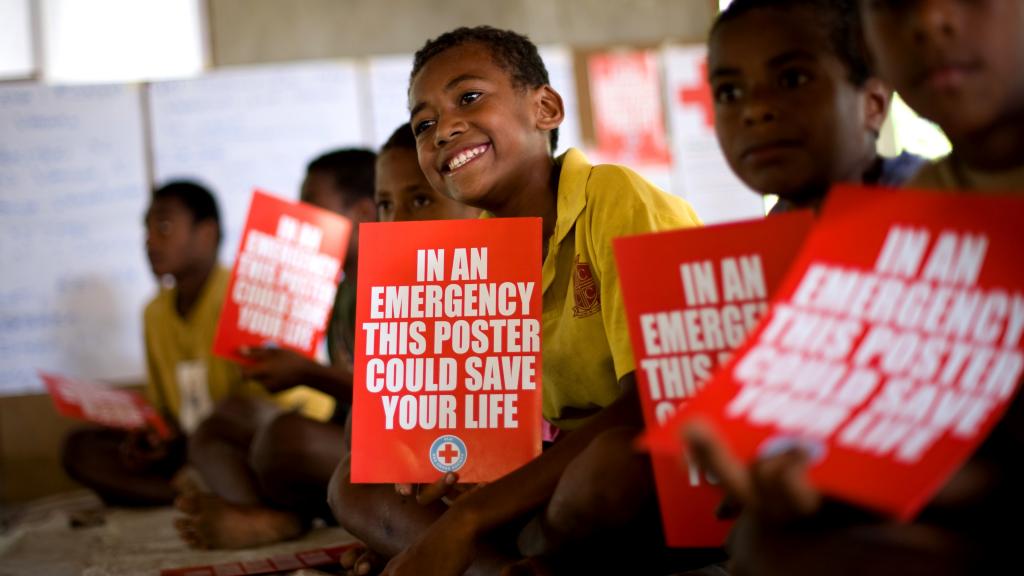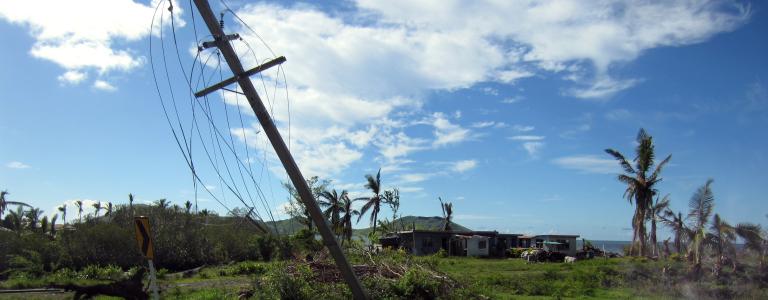Sink, Swim … or Fight Back
Helping countries adapt to climate change is central to the mission of the NAP Global Network, hosted by IISD.
When Cyclone Winston hit Fiji in February 2016, it killed dozens of people, left thousands homeless, devastated infrastructure, and caused huge economic losses.
“Winston taught us all a lesson and had an indelible impact on the national psyche,” said Josaia Voreqe Bainimarama, Fiji’s Prime Minister.
“We know that because of the stronger and more frequent storms caused by climate change, it is only a matter of time before Fiji is struck again.”
Prime Minister Bainimarama has prioritized climate adaptation for his country. (Photo: UN Geneva CC BY-NC-ND 2.0)
After Winston hit Fiji, the government quickly prioritized creating a National Adaptation Plan or NAP. Adaptation planning enables countries to identify and address their medium- and long-term priorities for adapting to climate change.
Through funding from the governments of Canada and the United States, the NAP Global Network helped Fiji create a national plan to make the country more climate resilient. The Fijian government worked with stakeholders in a participatory process to prioritize 160 actions in key sectors like health and food security. The NAP Global Network, hosted by IISD, is now supporting Fiji to put this plan into action.
It is only a matter of time before Fiji is struck again.
Fijians recognize that having the means to adapt is not just a policy objective—it’s a matter of survival.
Climate adaptation is one of two main responses to climate change: the other is climate mitigation. Mitigation is about lessening the flow and concentration of heat-trapping greenhouse gases in the atmosphere by reducing emissions and capturing and sequestering carbon.
Adaptation, on the other hand, is about adjusting to the impacts that are already being observed or that are anticipated in future. Put into practice, adaptation can take different forms: everything from building sea walls to guard against rising water levels to behaviour changes like using less water or planting crops that are drought- or flood-resistant.

As COVID-19 takes its toll on global economies, Fiji is no exception—its economy is expected to shrink by almost 5% this year due to travel restrictions. Tourism, responsible for 40% of the country’s GDP, has ground to a halt. Climate impacts have not relented either—in April, Cyclone Harold slammed into Fiji, destroying buildings and flooding towns.
NAPs are focused on climate change, but since climate change interacts with so many aspects of societies, economies, and ecosystems, preparing for its impacts often involves simultaneously addressing many issues that shape our lives. This makes the NAP process a valuable tool for responding to other threats, including fast-moving viruses like the one that causes COVID-19.
And that is why having a NAP is so important. As a threat multiplier, climate change will reverse development gains unless Fiji has the systems and capacities in place to anticipate, withstand, and recover from its impacts.
“We all need to focus as nations on our own adaptation measures,” said Bainimarama at the 2018 launch of the National Adaptation Plan. “I want to acknowledge and thank the NAP Global Network for providing us with the technical and financial support to develop this blueprint for our adaptation efforts.”
(Photo: Department of Foreign Affairs and Trade CC BY 2.0)
You might also be interested in
Clean Power With a Clean Conscience
Lowering our carbon footprint cannot come at the expense of people in the world’s most vulnerable places.
Solar Power Is Just a Switch Away
Swapping subsidies from fossil fuels to clean options can make renewables the most viable alternative.
Is It Raining Plastic?
We need more research to understand the effects of microplastics on our fresh water—and find solutions. That's where our team of experts come in.
How Fiji Does Climate Adaptation: Actions Speak Louder In Virtual Reality
Over here in the US, much of the climate adaptation talk has to do with the familiar topic of infrastructure. Massive structures of concrete and steel are only part of the solution, though. CleanTechnica caught wind of a United Nations project that leverages virtual reality to communicate the nuances of climate adaptation, and they have chosen an interesting location to explore: the islands of Veidrala, Narikoso, and Lekanai in Fiji.


